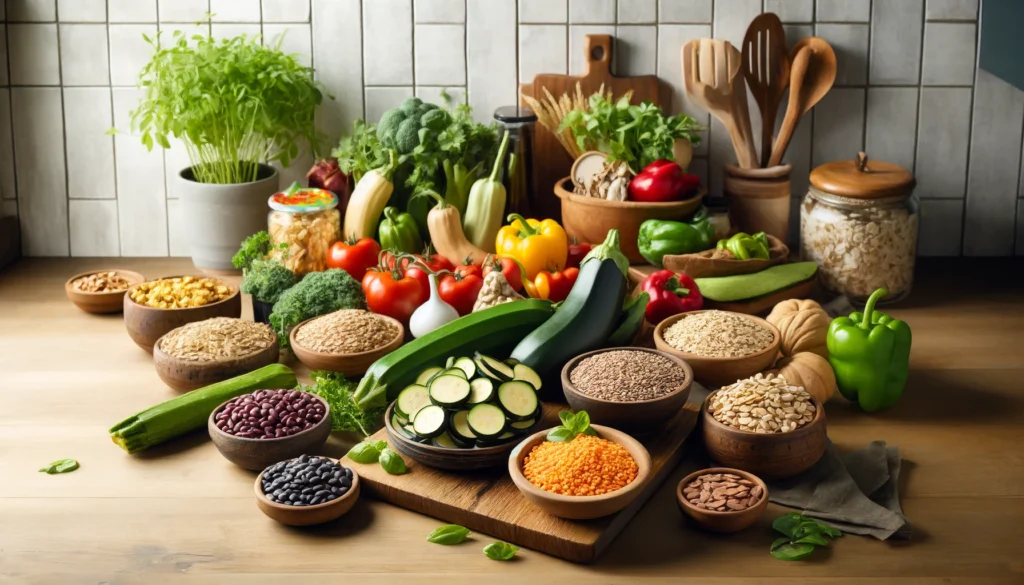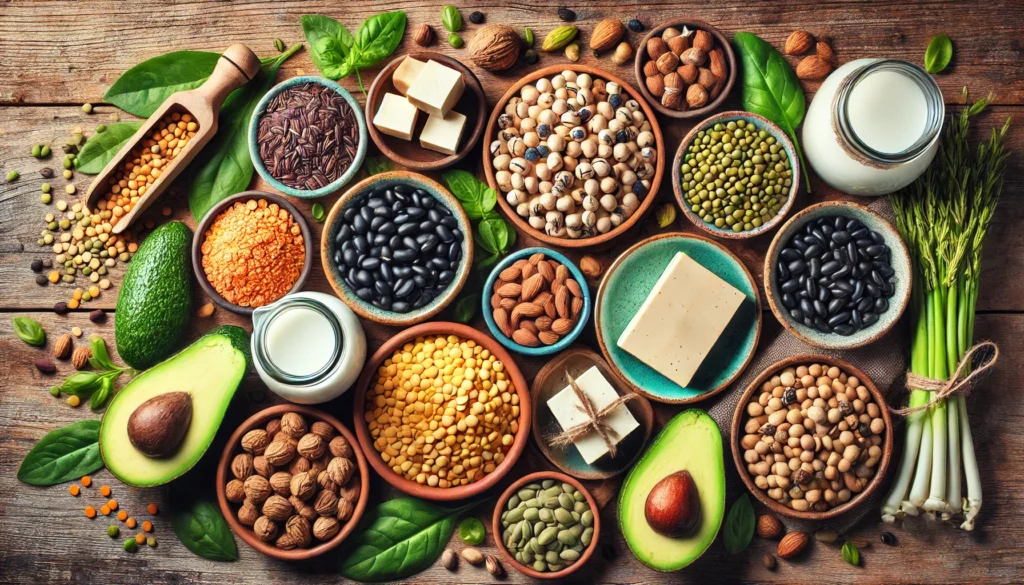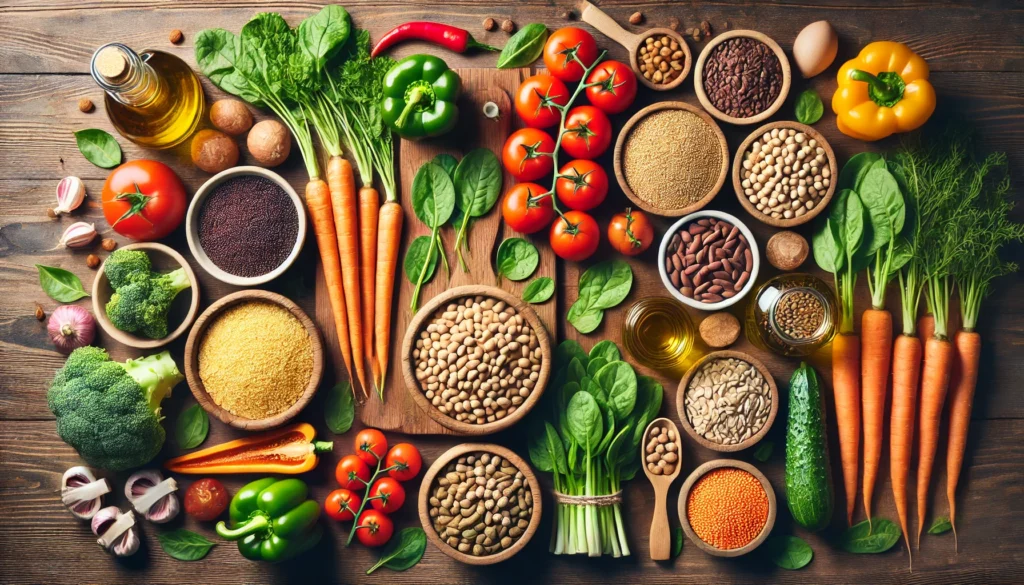Adopting a plant-based diet is an exciting journey toward improved health, environmental sustainability, and ethical food choices. Whether you are transitioning gradually or making an immediate shift, understanding the fundamental staples of some plant-based diets is crucial for maintaining a balanced and nutrient-dense eating plan. Plant-based diets emphasize whole, unprocessed foods derived from plants, including vegetables, fruits, grains, legumes, nuts, and seeds. By stocking up on essential ingredients, beginners can create satisfying, nutritious meals while ensuring they meet their dietary needs.
You may also like: How to Start a Whole Food Plant-Based Diet: A Beginner’s Guide to Healthier Eating
Understanding the Importance of Plant-Based Diet Staples
The foundation of any diet is its staple ingredients, and this principle holds true for plant-based eating. These staples provide essential macronutrients—carbohydrates, proteins, and fats—along with vital micronutrients such as vitamins, minerals, and antioxidants. The right combination of basic staples for plant-based recipes for beginners ensures a balanced diet that promotes energy, digestion, and overall well-being. Whole grains, legumes, fresh and dried fruits, vegetables, nuts, and seeds form the cornerstone of plant-based nutrition. These ingredients support a wide range of culinary applications, from simple salads and soups to elaborate main courses and baked goods. Understanding these staple components is key to creating meals that are both nourishing and flavorful.

Whole Grains: The Backbone of a Plant-Based Pantry
Whole grains are a staple of some plant-based diets due to their high fiber content, slow-digesting carbohydrates, and abundance of essential nutrients. Unlike refined grains, whole grains retain their bran, germ, and endosperm, making them a superior choice for sustained energy and gut health. Brown rice, quinoa, oats, farro, bulgur, and whole wheat products offer diverse textures and flavors suitable for breakfast, lunch, and dinner.
Quinoa, often considered a superfood, is a complete protein source, meaning it contains all nine essential amino acids. This quality makes it particularly valuable for those transitioning to a plant-based diet. Brown rice, another versatile grain, pairs well with vegetables, legumes, and sauces, making it an ideal base for hearty meals. Oats, whether rolled or steel-cut, serve as a nourishing breakfast option packed with soluble fiber that supports heart health and digestion. Farro and bulgur add depth to salads and pilafs, offering nutty flavors and chewy textures that enhance the overall meal experience.
Legumes: A Powerful Protein and Fiber Source
Legumes, including beans, lentils, chickpeas, and peas, are foundational plant-based diet staples that provide high-quality protein, fiber, and a wide array of essential nutrients. Their versatility makes them suitable for soups, stews, salads, dips, and even plant-based burger patties. Lentils, available in various colors such as green, red, and black, cook quickly and serve as excellent meat substitutes in dishes like lentil soups, curries, and shepherd’s pie.
Chickpeas, another widely used legume, are the primary ingredient in hummus and falafel and work well in salads, stir-fries, and grain bowls. Black beans and kidney beans contribute robust texture and depth to chili, tacos, and burritos, while split peas create comforting, protein-rich soups. Legumes not only provide ample protein but also deliver complex carbohydrates and iron, making them essential for balanced plant-based nutrition.
Vegetables: The Heart of Plant-Based Eating
Fresh and frozen vegetables form the foundation of a nutritious plant-based diet. Dark leafy greens such as kale, spinach, collard greens, and Swiss chard provide essential vitamins like A, C, and K, as well as iron and calcium. Cruciferous vegetables, including broccoli, cauliflower, Brussels sprouts, and cabbage, contain powerful antioxidants and compounds that support cellular health.
Root vegetables like carrots, sweet potatoes, and beets offer natural sweetness and a high content of fiber and beta-carotene. Bell peppers, zucchini, eggplant, and mushrooms enhance meals with their vibrant colors, varied textures, and nutrient-rich profiles. Incorporating a variety of vegetables into daily meals ensures a diverse intake of essential vitamins, minerals, and phytonutrients, supporting immune function, digestion, and overall vitality.
Fruits: A Natural Source of Nutrients and Sweetness
Fruits provide natural sugars, vitamins, minerals, and fiber while adding a refreshing sweetness to meals and snacks. Berries such as strawberries, blueberries, and raspberries are packed with antioxidants and vitamin C, promoting immune health and cognitive function. Bananas, rich in potassium, serve as a convenient snack and an excellent base for smoothies and dairy-free baking.
Apples, pears, and citrus fruits offer fiber and hydration, making them ideal for digestion and sustained energy. Dried fruits such as dates, raisins, and figs are nutrient-dense additions to oatmeal, granola, and desserts. Fresh and dried fruits contribute to the diversity of a plant-based diet while providing essential nutrients needed for overall well-being.
Nuts and Seeds: Essential Sources of Healthy Fats
Nuts and seeds are essential for obtaining healthy fats, protein, and micronutrients in a plant-based diet. Almonds, walnuts, cashews, and pistachios offer heart-healthy monounsaturated fats, while flaxseeds, chia seeds, and hemp seeds provide omega-3 fatty acids crucial for brain function and cardiovascular health. Pumpkin seeds and sunflower seeds supply magnesium and zinc, which support immune function and energy metabolism.
Nut and seed butters, such as almond butter and tahini, enhance plant-based meals by adding creaminess and depth of flavor. These ingredients contribute to balanced nutrition and satiety, making them valuable additions to any plant-based pantry.

Frequently Asked Questions (FAQ) About Plant-Based Diet Staples
1. What are the best plant-based diet staples for beginners?
When transitioning to a plant-based diet, beginners should focus on a selection of versatile and nutrient-dense staples that support a well-rounded eating plan. Whole grains such as quinoa, brown rice, and oats serve as an excellent foundation, providing long-lasting energy and essential nutrients. Legumes, including lentils, chickpeas, and black beans, are rich in protein and fiber, helping to maintain satiety and digestive health. Fresh and frozen vegetables, particularly dark leafy greens, cruciferous varieties, and root vegetables, offer essential vitamins and antioxidants. Nuts, seeds, and plant-based oils, such as flaxseeds, chia seeds, and avocado oil, contribute healthy fats necessary for brain and heart function. By incorporating these plant-based diet staples, beginners can create a diverse range of meals while meeting their nutritional needs.
2. How can I ensure I am getting enough protein on a plant-based diet?
A common concern for those new to plant-based eating is obtaining sufficient protein, but with proper planning, it is entirely achievable. Legumes, including lentils, black beans, and chickpeas, are a staple of some plant-based diets, offering substantial protein content alongside fiber. Tofu, tempeh, and edamame are excellent soy-based sources that provide complete proteins, meaning they contain all nine essential amino acids. Whole grains like quinoa and farro contribute additional protein, making them valuable for balanced meals. Nuts and seeds, such as almonds, hemp seeds, and pumpkin seeds, offer both protein and healthy fats. By combining various plant-based protein sources throughout the day, individuals can easily meet their protein requirements without relying on animal products.
3. What are the basic staples for plant-based recipes for beginners?
For those just starting a plant-based diet, having the right pantry staples ensures smooth meal preparation and balanced nutrition. Dry goods like lentils, beans, and chickpeas serve as the backbone of many hearty dishes, including soups, stews, and salads. Whole grains such as quinoa, brown rice, and oats provide essential carbohydrates and fiber, making them versatile ingredients for breakfasts, grain bowls, and side dishes. Fresh and frozen vegetables, including bell peppers, broccoli, and spinach, are critical for adding nutrients and flavor to meals. Nuts and seeds, like walnuts, sunflower seeds, and flaxseeds, contribute protein and essential fatty acids. Keeping plant-based condiments such as tahini, nutritional yeast, and coconut aminos on hand enhances the flavor and nutrient profile of basic plant-based recipes.
4. Are plant-based diet staples expensive?
Contrary to popular belief, a plant-based diet does not have to be costly; in fact, it can often be more affordable than a diet centered on animal products. Legumes, grains, and vegetables tend to be some of the most budget-friendly foods available, particularly when purchased in bulk. Staple of some plant-based diets, such as lentils, brown rice, and canned beans, offer high nutritional value at a low cost. Seasonal and locally sourced produce can be more affordable than out-of-season items, helping to reduce overall grocery expenses. Frozen fruits and vegetables are another cost-effective option that provides year-round access to nutrient-rich foods without spoilage. Meal planning, cooking at home, and focusing on unprocessed whole foods make maintaining a plant-based diet both financially manageable and nutritionally optimal.
5. Can I still eat processed foods on a plant-based diet?
While whole, unprocessed foods should form the core of a healthy plant-based diet, some processed options can be included in moderation. Many packaged plant-based alternatives, such as tofu, tempeh, and unsweetened plant-based milks, provide valuable nutrients without excessive additives. However, highly processed foods such as mock meats, plant-based cheeses, and refined grain products should be consumed mindfully, as they may contain artificial ingredients and high sodium levels. When selecting processed foods, reading ingredient labels is essential to ensure they align with a whole-food, plant-based lifestyle. Making homemade versions of processed staples, such as dairy-free sauces, vegetable broths, and plant-based burgers, can provide healthier alternatives while retaining full control over ingredients.
6. How do I create balanced meals with plant-based diet staples?
A well-balanced plant-based meal should incorporate a variety of food groups to ensure adequate macronutrient and micronutrient intake. A base of whole grains, such as quinoa or brown rice, provides complex carbohydrates for sustained energy. Adding a source of plant-based protein, such as lentils, beans, or tofu, ensures muscle maintenance and satiety. Including a generous portion of colorful vegetables enhances the meal with fiber, vitamins, and antioxidants. Healthy fats from avocados, nuts, or seeds contribute essential fatty acids necessary for brain health and hormone balance. Lastly, incorporating flavorful herbs, spices, and plant-based condiments enhances taste while providing additional health benefits.
7. What are some easy plant-based recipes for beginners?
Beginners can start with simple, wholesome recipes that showcase plant-based diet staples while requiring minimal preparation. A nourishing breakfast option is overnight oats, combining rolled oats, plant-based milk, chia seeds, and fruit for a fiber-rich start to the day. Lentil soup, made with carrots, tomatoes, and spices, is a protein-packed meal that is easy to prepare in bulk. Chickpea stir-fry with bell peppers and soy sauce offers a quick and flavorful dinner option. Quinoa salad with cucumbers, cherry tomatoes, and a lemon-tahini dressing is a refreshing, nutrient-dense meal suitable for any season. These basic staples for plant-based recipes for beginners allow for customization based on personal preferences and ingredient availability.
8. What should I look for when buying plant-based staples at the grocery store?
When shopping for plant-based diet staples, selecting high-quality, minimally processed ingredients ensures optimal nutrition. Look for whole grains like brown rice, quinoa, and whole wheat pasta, avoiding refined grains with added sugars and preservatives. Choose dried or canned legumes with no added salt or preservatives to maximize their nutritional benefits. Fresh produce should be diverse in color, as different pigments indicate a range of essential vitamins and antioxidants. For plant-based dairy alternatives, opt for unsweetened varieties of almond, soy, or oat milk to avoid excess sugar. Prioritizing organic and non-GMO options when possible can further enhance the healthfulness of plant-based food choices.
9. How can I meal prep effectively with plant-based diet staples?
Meal prepping with plant-based staples allows for efficient cooking and ensures access to nutritious meals throughout the week. Cooking large batches of grains such as quinoa or brown rice in advance provides a quick base for multiple dishes. Preparing and storing cooked beans, lentils, or chickpeas simplifies meal assembly while maintaining high protein intake. Chopping and portioning vegetables in advance reduces prep time and encourages daily consumption. Making homemade sauces, such as hummus or tahini dressing, enhances meal variety and flavor. Planning meals ahead of time and utilizing leftovers creatively minimizes food waste and maximizes nutritional benefits.
10. What are the long-term benefits of maintaining a diet rich in plant-based staples?
Consistently consuming plant-based diet staples supports long-term health, sustainability, and overall well-being. Diets rich in whole grains, legumes, fruits, and vegetables have been linked to lower risks of chronic diseases such as heart disease, diabetes, and hypertension. The high fiber content in plant-based foods aids digestion, promotes gut health, and contributes to weight management. Reducing reliance on animal products helps decrease environmental impact by conserving water, reducing greenhouse gas emissions, and minimizing land use. By focusing on diverse, nutrient-dense foods, individuals can sustain a plant-based lifestyle that enhances longevity, vitality, and planetary health.

Conclusion: Building a Sustainable Plant-Based Kitchen
Stocking a kitchen with essential staples for a plant-based diet ensures the ability to create nourishing, satisfying meals with ease. Understanding the role of whole grains, legumes, vegetables, fruits, nuts, and seeds provides a strong foundation for meal planning and cooking. By incorporating these ingredients into daily eating habits, individuals can enjoy the health benefits and culinary delights of plant-based nutrition. Whether preparing simple plant-based recipes or experimenting with diverse cuisines, maintaining a well-stocked pantry supports long-term success on a plant-based journey.
Further Reading:
Beginner’s Guide to A Whole-Foods, Plant-Based Diet
7-Day Plant-Based Diet Meal Plan for Beginners, Created by a Dietitian
7-Day Vegan Meal Plan for Beginners, Created by a Dietitia
plant-based nutrition, whole food plant-based, vegan pantry essentials, healthy plant-based eating, plant-based protein sources, nutrient-dense plant foods, beginner vegan staples, plant-based grocery list, whole grains and legumes, sustainable eating habits, healthy meat alternatives, plant-based meal planning, dairy-free diet essentials, high-protein plant foods, fiber-rich foods, vegan meal prep ideas, plant-based lifestyle tips, budget-friendly plant-based foods, clean eating on a plant-based diet, best vegan ingredients
The information contained in this article is provided for general informational purposes only and is not intended to serve as medical, legal, or professional advice. While NewsHealthWatch strives to present accurate, up-to-date, and reliable content, no warranty or guarantee, expressed or implied, is made regarding the completeness, accuracy, or adequacy of the information provided. Readers are strongly advised to seek the guidance of a qualified healthcare provider or other relevant professionals before acting on any information contained in this article. NewsHealthWatch, its authors, editors, and contributors expressly disclaim any liability for any damages, losses, or consequences arising directly or indirectly from the use, interpretation, or reliance on any information presented herein. The views and opinions expressed in this article are those of the author(s) and do not necessarily reflect the official policies or positions of NewsHealthWatch.

